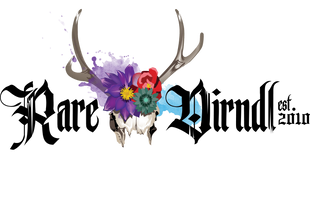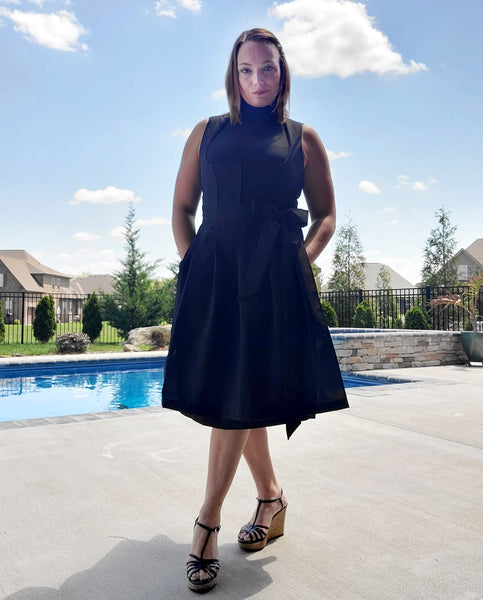Dirndl Color Meanings and History

In this Article:
- Evolution of the Traditional Dirndl
- Dirndl Color Meaning, Trends, & Groups
- Dirndl Color Theory
- Do colors have meaning at Oktoberfest?
Evolution of the Traditional Dirndl
In the late 1800s, the dirndl style began to evolve as it became fashionable among the upper class in Germany and Austria. Wealthy women started to wear dirndls made from more luxurious fabrics like silk and velvet, and the style became more ornate and decorative. The dirndl became a symbol of national pride, and the fashion industry began to take notice of this popular style.
The dirndl is a quintessential part of traditional German women's clothing, and its styling varies by region and occasion. A traditional dirndl typically consists of a blouse, skirt, and apron. The blouse is often white, with puffed sleeves and a lower neckline, and is worn under the bodice of the dirndl dress. The bodice and skirt can be made of various fabrics, including cotton, silk, or wool, and the skirt features a full or slightly gathered silhouette.
The length of the skirt can vary from ankle-length to knee-length, depending on the occasion. The dirndl apron is an important part of the dirndl and is usually made of a contrasting fabric. It is tied around the waist, over the skirt.

The dirndl, as a symbol of traditional German culture, underwent a shift in attitudes during and after World War II. During the war, the dirndl was seen as a representation of the Nazi party and its emphasis on nationalism and traditional values (not the dirndl's most shining moment to say the least).
As a result, its popularity declined (because... duh) and the style became more subdued and practical. However, in the post-war period, attitudes towards the dirndl began to shift once again. The dirndl was seen as a way to reconnect with traditional German culture and celebrate the country's heritage.
In the late 20th century, its popularity increased, and the style evolved to incorporate new fabrics, patterns, and embellishments. The attitude towards the dirndl has shifted from being a political statement to a fashion statement that celebrates the past while remaining relevant in the present.

The dirndl style continued to evolve as it became more modern and streamlined. What comes to mind when someone says, "traditional dirndl" from this era is a longer dirndl with small and subtle floral prints and stripes.
Dirndl Color Combinations & Modern Dirndls
Classic color combinations of pink, green and ivory, blue red and yellow, white and green... I can close my eyes and feel the starched cotton and fabric hovering around my ankles. Dirndl skirt lengths have also had their own evolution. You can read more about it in our article: Traditional Dirndl Skirts: Finding the Right Length for You
Designers began to experiment with different fabrics, colors, and patterns to create new looks that still honored the traditional roots of the dirndl. The dirndl as the traditional dress became a popular style among women of all ages, and it was no longer restricted to rural areas or special occasions.

Today, the dirndl style is still a popular fashion choice, both in Germany and around the world. Modern dirndls come in a variety of styles, from classic and traditional to trendy and edgy. The fabrics used to make dirndls have also expanded to include lightweight cotton and unique and contemporary materials, making the dirndl more comfortable and versatile than ever before.
Dirndl Dresses at Oktoberfest
The popularity of the dirndl for Oktoberfest can be traced back to the festival's origins in the early 19th century. Initially, Oktoberfest celebrated the marriage of Crown Prince Ludwig and Princess Therese of Saxe-Hildburghausen in 1810, and attendees enjoyed horse races and other festivities. Over time, the festival grew in size and popularity, and traditional Bavarian clothing, including the dirndl, became a common sight among them. Today, both locals and tourists attending the festival wear the dirndl, making it a staple garment.

Overall, the evolution of the dirndl style has been a fascinating journey that has embraced both tradition and modernity. While the basic design elements of this cultural dress remain the same, the style has continued to evolve and adapt to the changing times.
The dirndl has become an iconic symbol of German and Austrian culture, and its popularity shows no signs of slowing down anytime soon (yay!!). The modern dirndl is most commonly worn to events such as the Munich Oktoberfest, Frühlingsfest and other folk festivals.

Dirndl Color Meaning, Trends, & Groups
Traditional German Dirndls are known for their distinctive design and vibrant colors. Back in the day, (which was like the early 1900s maybe) you could tell which town or part of the country you were from based on the unique colors and/or style of the dirndl. These traditional outfits were steeped in symbolism and cultural significance.
Today, however, the only things that can be linked to have any meaning when it comes to color is simply based on classic color theory. Unless you have access to a vintage dirndl dress worn during these time periods (and an oral history to go with it) there is nothing super culturally significant about the color combinations of dirndl dresses. If you wear a black and red dirndl to Oktoberfest, no one is going to immediately assume you're family is from the black forest region etc.

In today’s society, the only instance I can think of where a color or dirndl style would signify belonging to a certain group is with cultural dance or singing groups. For example, I used to dance with the American Aid Society of German Descendants and our dirndls were always red with a white apron and a white blouse, while the other group from Chicago, Chicago Donauschwaben, had blue dirndls with a white blouse and white apron. At larger functions, where we were all together, you could tell who belong to which group based on their dirndl. However, after we danced, we would change into our personal dirndl, and then the color became irrelevant.

Dirndl Color Theory
Below is a basic exploration of color theory and how it could have significance in German dirndls. The following are to be considered opinions and not historical facts.
Blue

Blue is a popular color choice and is often associated with traditional Bavarian clothing. The color blue is said to represent loyalty, harmony, and fidelity. This is a perfect color for weddings or other important celebrations, as it symbolizes commitment and unity. Blue dirndls are often paired with white aprons, which symbolize purity and innocence. Overall, blue dirndls are a classic and elegant choice for any occasion.
Red

Red dirndls are another popular color choice and are often associated with passion and love. Red symbolizes energy, courage, and vitality. Women often wear red dirndls to festivals or other events to stand out from the crowd and show their confidence. Red dirndls can also be paired with black or white aprons for a more formal look.
Green

Green dirndls are less common but are still a beautiful and meaningful choice. Green symbolizes growth, nature, and fertility. Women often wear green dirndls during the spring and summer months to celebrate new beginnings and the beauty of nature. Green dirndls are often paired with light colors or brown aprons, which complement the earthy tones of the dirndl dress.
Green is also associated most often with Austrian dirndl dresses. A combination of pink and green is very traditional in certain regions of Austria.
Pink

Pink dirndls are a playful and feminine choice. Pink symbolizes love, romance, and sweetness. Women often wear pink dirndls to festivals or other events to show their playful side and have fun. Pink dirndls can be paired with light-colored aprons for a more delicate look, or with dark aprons for a more bold and dramatic statement.
Yellow

Yellow dirndls are a bright and cheerful choice. Yellow symbolizes happiness, optimism, and positivity. People often wear yellow dirndls during the summer months to celebrate the sunshine and warmth. Yellow dirndls are often paired with light colors, which complement the cheerful color of the dress.
Purple

Purple dirndls are a regal and sophisticated choice. Purple symbolizes luxury, power, and nobility. Traditionally folk would wear purple to formal events or celebrations to show their elegance and sophistication. Purple dirndls are often paired with florals for a classic and timeless look.
Black
Black dirndls are a bold and dramatic choice. Black symbolizes strength, power, and sophistication. Women often wear black dirndls to formal events or celebrations to make a statement and stand out from the crowd. Black dirndls can be paired with white or silver aprons for a more formal look, or with colorful aprons for a more playful and daring look. Black is also the first choice for members of the alternative and goth communities who want to stay true to their personal style while also embracing the Bavarian culture. You read that right... Goth Dirndl.
Even if you don't consider yourself an alternative gal, black is a timeless choice. Our best-selling dirndl from our online store is the Little Black Dirndl for goodness sake!

Ivory
Ivory or white when combined with brights and is also a versatile color that can complement many skin tones and color palettes.
When worn as the primary color, it is most commonly reserved for Bridal Dirndls. Wearing a dirndl as a wedding dress can have different meanings depending on the person and their cultural background. In Bavarian culture, the dirndl is a traditional dress worn by women for festive occasions, and it represents a connection to regional traditions and customs. For some brides, having a dirndl as a wedding dress can be a way to honor their family's heritage or their personal connection to Bavarian culture. Additionally, the dirndl is often seen as a more modest and practical option compared to a traditional wedding gown, which may appeal to brides who value simplicity and comfort.

Do colors have meaning at Oktoberfest?
The short answer is no. Again the only folks who are wearing tracht of a specific color belong to a group. If you are attending the Munich Oktoberfest with your friends and/or family, there are no color rules. The only rule when it comes to traditional dresses is explained in this article > What NOT to Wear to Oktoberfest. And don't worry, there is no such thing as special Oktoberfest dirndls. A dirndl is a dirndl, and long as it's not a cheap, uber short beer wench costume, it works.

Since starting Rare Dirndl in 2010, as the founder and designer, I’ve had my pulse on the dirndl and its trends. I've got a solid understanding of the fabrics, colors, and patterns that make up this traditional garment, and a keen eye for incorporating contemporary elements into designs while remaining true to the essence of the dirndl. That being said, there is always so much to learn! If you have any knowledge on this topic you'd like to share, write them in the comments.

Disclosure: The above information is based on personal experience and observation.
Looking for more styling tips? Check out our comprehensive Dirndl Style Guide. Click here to download it today



Comments
Kerry Vondrak said:
Hello, I was wondering if you could help with a question. Is there a name for the dirndls that the festival dancers wear with stripes or black ribbons on the bottom. Thank you!